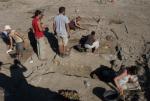Summary (English)
Excavations continued in the area on the seaward side of the 19th century masseria known as the Casino Macrì. Further evidence was documented, relating to the layout of the structures dating to the first century of the Greek colony’s life, as well as elements confirming the proposed reconstruction for the central area of the archaic town, characterised by the presence of a wide channel for the regulation of the waters from the Milligri torrent, which had been restructured several times.
Particular attention was paid to the exploration of the sacred area situated immediately north of the channel. Four rooms and a corridor arranged around a courtyard were partially excavated. The complex revealed its use for cult purposes between the second half of the 4th-3rd century B.C., with various phases of restructuring. Among the evidence for ritual activities was a deposit containing numerous offerings. These included about sixty loom weights of various sizes, some with relief decorated of gorgoneia, associated with plain ware pottery and fine wares, as well as shells and animal bones. More shells and loom weights were found in other points of the sanctuary together with figured terracottas.
Numerous fragments of a model grotto, first identified during the 2011 campaign, were recovered. Many aspects of its iconography make it unique in the Locri series of grotto-nymphaeums. The evidence collected confirmed the pertinence of this sacred area to pre-matrimonial cult practices linked to the ritual use of water, similar to those already attested at Locri in the extra-urban sanctuary of Grotta Caruso.
The excavation was extended and deepened in the southern part of the area, which was densely occupied during the Roman period. Here, a complex stratigraphy showing five successive phases, dating to between the 2nd and 6th-7th centuries A.D. was investigated. A period of intense building activity was documented for the 4th-5th century A.D.
- Diego Elia - Università degli Studi di Torino, Dipartimento di Studi Storici
Director
Team
- Carla Scilabra
- Marco Serino
- Barbara Carè
- Valeria Meirano - Università degli Studi di Torino, Dipartimento di Studi Storici
- Studenti e laureandi dell’Università di Torino, Lione, Palermo, Bologna e Salento
Research Body
- Università degli Studi di Torino – Dipartimento di Studi Storici
Funding Body
- Associazione culturale Kairós. Centro studi archeologici






![Download [PDF]](/excavation/skins/fasti/images/results/download_sml.png)